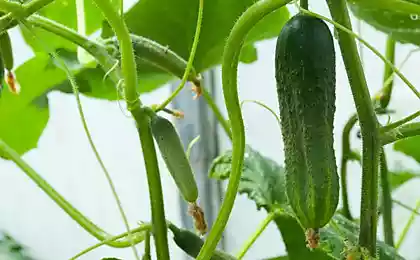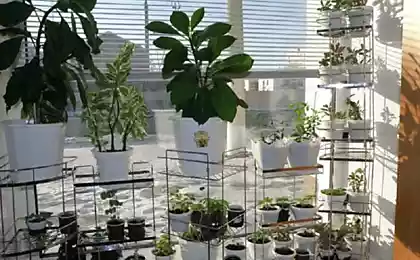498
How to grow POMEGRANATE on the windowsill
Among the fans of indoor exotic plants pomegranate is very popular. This plant is pleasing to the eye at any time of the year with its scarlet, crimson or bright red flowers, small oblong green leaves, as well as the original fruit, like red lanterns.
At the same time, these plants are undemanding and require no special care. In pot culture it is possible to form either a tree with a low trunk or a Bush with 4 to 5 trunks, pomegranate is also suitable for growing bonsai. A well formed plant in the form of a tree has a very attractive decorative appearance.

In the nature garden forms garnet – evergreen trees or deciduous shrubs. Among garden forms, there are many decorative varieties with flowers of various hues. Some ornamental pomegranates do not bear fruit, but are successfully used for hedges in the compositions of the landscape design.
The quickest way to obtain's a fruit plant – rooted cutting from otplodonosivshih, well ripened escape. Best of all cuttings rooted in early spring in February – March. In the summer you can root cuttings with semilignified shoots, but rooting is slower. Plants grown from cuttings fruit, bloom for 2-3 year after planting. Not recommended for reproduction to produce root sprouts, as such plants will give a lot of root shoots.
To hasten the onset of fruiting by seedlings from seeds with subsequent inoculation. You can take seeds from the fruit sold in the market. Thus grown seedlings are rather strong, with well-developed root system, which subsequently grafted the desired variety. When planting seeds they should first be cleaned from the pulp, washed with water, and sown in the ground to a depth of 5-7 mm. When grown from seed varietal characteristics the seedlings are transferred. These plants come into bearing in 4-5 year of life. Grafted plants bloom the following year. Vaccination can make the split, under bark and budding. The technique of grafting is no different from grafting other fruit trees. In splitting and under-bark inoculations performed in the spring, after a dormant period, do budding in August of the sleeping eye. Grafted plants should be protected from direct sunlight until full coalescence of the Scion with the rootstock.
Particularly popular among lovers of exotic uses dwarf form common pomegranate (Punica granatum nana) – the plant is evergreen and practically do not shed their leaves even during winter holidays. In the common room culture is also varieties of "Baby" and "Uzbekistan". Tall plants reach 30 – 60cm, very decorative and are of early fruiting. Seedlings of dwarf pomegranates grown from seed may bloom and bear fruit in the first year, but to load their harvest is only recommended in the second year. Room type of pomegranate "Baby" blossoms abundantly, but the fruit requires artificial pollination.

For planting dwarf varieties of pomegranate is quite suitable pot with a volume of 0.3 – 0.5 liters, filled with a mixture of leaf, humus, sod of earth and sand mixed in the ratio of 1:0.5:1:1. Pomegranate root system is shallow, so the dishes for planting you need to choose is not high, but quite wide. Soil mixture should have a slightly alkaline reaction. To the ground quickly dried up, on top of the soil, pour a layer of pebbles or clay pellets. Pour the pomegranate separated by water, hard water is not harmful to him.
Young plants should be transplanted every year in the spring, adults every 2-3 years. Transplanting is better done in the spring when the buds swell. Garnet – photophilous plant, it is best to contain it in the South or South-West window during the growing season requires fresh air, moderate watering and fertilizer. With good care pomegranate may bloom all summer. The fruit of the dwarf varieties with a diameter of 2-4 cm, ripen in autumn. They are as tasty and healthy as that of large plants. Although the fruit can hang on the tree until spring, it is better to take them off in November before preparing the trees to rest, which it definitely needs.
Rested a plant abundant flowering and fruiting in the following year.
The leaves and shoots of garnet can be red arachnoid mites, whiteflies, aphids, and powdery mildew. To ensure that your plant is not lost decorative appeal, regularly inspect and timely take measures to combat diseases and pests. published
P. S. And remember, only by changing their consumption — together we change the world! ©
Join us in Facebook , Vkontakte, Odnoklassniki
Source: dizstyle.ru/dizain-interjer-dekor/domovodstvo/vyrashivaem-granat-ekzotika-na-podokonnike.html
At the same time, these plants are undemanding and require no special care. In pot culture it is possible to form either a tree with a low trunk or a Bush with 4 to 5 trunks, pomegranate is also suitable for growing bonsai. A well formed plant in the form of a tree has a very attractive decorative appearance.

In the nature garden forms garnet – evergreen trees or deciduous shrubs. Among garden forms, there are many decorative varieties with flowers of various hues. Some ornamental pomegranates do not bear fruit, but are successfully used for hedges in the compositions of the landscape design.
The quickest way to obtain's a fruit plant – rooted cutting from otplodonosivshih, well ripened escape. Best of all cuttings rooted in early spring in February – March. In the summer you can root cuttings with semilignified shoots, but rooting is slower. Plants grown from cuttings fruit, bloom for 2-3 year after planting. Not recommended for reproduction to produce root sprouts, as such plants will give a lot of root shoots.
To hasten the onset of fruiting by seedlings from seeds with subsequent inoculation. You can take seeds from the fruit sold in the market. Thus grown seedlings are rather strong, with well-developed root system, which subsequently grafted the desired variety. When planting seeds they should first be cleaned from the pulp, washed with water, and sown in the ground to a depth of 5-7 mm. When grown from seed varietal characteristics the seedlings are transferred. These plants come into bearing in 4-5 year of life. Grafted plants bloom the following year. Vaccination can make the split, under bark and budding. The technique of grafting is no different from grafting other fruit trees. In splitting and under-bark inoculations performed in the spring, after a dormant period, do budding in August of the sleeping eye. Grafted plants should be protected from direct sunlight until full coalescence of the Scion with the rootstock.
Particularly popular among lovers of exotic uses dwarf form common pomegranate (Punica granatum nana) – the plant is evergreen and practically do not shed their leaves even during winter holidays. In the common room culture is also varieties of "Baby" and "Uzbekistan". Tall plants reach 30 – 60cm, very decorative and are of early fruiting. Seedlings of dwarf pomegranates grown from seed may bloom and bear fruit in the first year, but to load their harvest is only recommended in the second year. Room type of pomegranate "Baby" blossoms abundantly, but the fruit requires artificial pollination.

For planting dwarf varieties of pomegranate is quite suitable pot with a volume of 0.3 – 0.5 liters, filled with a mixture of leaf, humus, sod of earth and sand mixed in the ratio of 1:0.5:1:1. Pomegranate root system is shallow, so the dishes for planting you need to choose is not high, but quite wide. Soil mixture should have a slightly alkaline reaction. To the ground quickly dried up, on top of the soil, pour a layer of pebbles or clay pellets. Pour the pomegranate separated by water, hard water is not harmful to him.
Young plants should be transplanted every year in the spring, adults every 2-3 years. Transplanting is better done in the spring when the buds swell. Garnet – photophilous plant, it is best to contain it in the South or South-West window during the growing season requires fresh air, moderate watering and fertilizer. With good care pomegranate may bloom all summer. The fruit of the dwarf varieties with a diameter of 2-4 cm, ripen in autumn. They are as tasty and healthy as that of large plants. Although the fruit can hang on the tree until spring, it is better to take them off in November before preparing the trees to rest, which it definitely needs.
Rested a plant abundant flowering and fruiting in the following year.
The leaves and shoots of garnet can be red arachnoid mites, whiteflies, aphids, and powdery mildew. To ensure that your plant is not lost decorative appeal, regularly inspect and timely take measures to combat diseases and pests. published
P. S. And remember, only by changing their consumption — together we change the world! ©
Join us in Facebook , Vkontakte, Odnoklassniki
Source: dizstyle.ru/dizain-interjer-dekor/domovodstvo/vyrashivaem-granat-ekzotika-na-podokonnike.html
7 SECRETS of people who know how not to be distracted
This drink's beauty is a champion in content of fatty acids






















